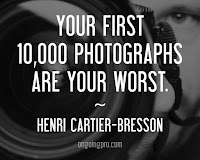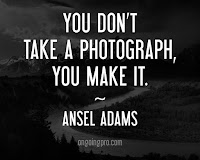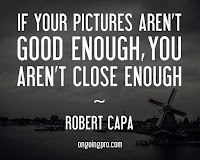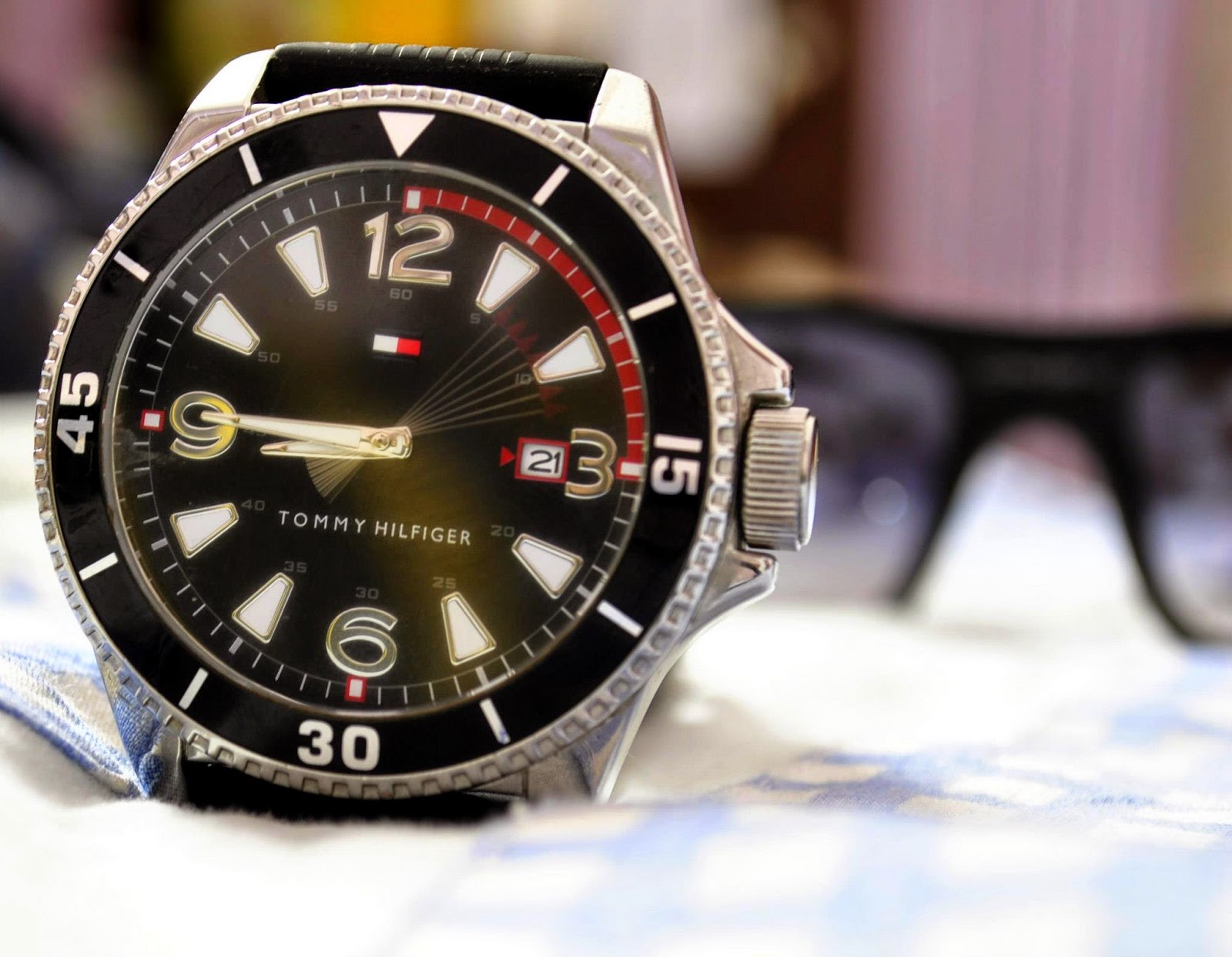Showing posts with label photography. Show all posts
Showing posts with label photography. Show all posts
Monday, February 22, 2016
In
famous photographers,
great quotes,
inspiration,
photography,
the world of photography,
what does it stand for
by Unknown
//
9:55 AM
//
Leave a Comment
What is photography really about
Photography is the science, art and practice of creating durable images by recording light or other electromagnetic radiation, either electronically by means of an image sensor, or chemically by means of a light-sensitive material such as photographic film.
Typically, a lens is used to focus the light reflected or emitted from objects into a real image on the light-sensitive surface inside a cameraduring a timed exposure. With an electronic image sensor, this produces an electrical charge at each pixel, which is electronically processed and stored in a digital image file for subsequent display or processing. The result with photographic emulsion is an invisiblelatent image, which is later chemically "developed" into a visible image, either negative or positive depending on the purpose of the photographic material and the method of processing. A negative image on film is traditionally used to photographically create a positive image on a paper base, known as a print, either by using an enlarger or by contact printing.
Photography is employed in many fields of science, manufacturing (e.g., photolithography) and business, as well as its more direct uses for art, film and video production, recreational purposes, hobby, and mass communication.
The word "photography" was created from the Greek roots φωτός (phōtos), genitive of φῶς (phōs), "light" and γραφή (graphé) "representation by means of lines" or "drawing", together meaning "drawing with light".
Several people may have coined the same new term from these roots independently. Hercules Florence, a French painter and inventor living in Campinas, Brazil, used the French form of the word, photographie, in private notes which a Brazilian photography historian believes were written in 1834. Johann von Maedler, a Berlin astronomer, is credited in a 1932 German history of photography as having used it in an article published on 25 February 1839 in the German newspaper Vossische Zeitung.Both of these claims are now widely reported but apparently neither has ever been independently confirmed as beyond reasonable doubt. Credit has traditionally been given to Sir John Herschel both for coining the word and for introducing it to the public. His uses of it in private correspondence prior to 25 February 1839 and at his Royal Society lecture on the subject in London on 14 March 1839 have long been amply documented and accepted as settled facts.
Around the year 1800, Thomas Wedgwood made the first known attempt to capture the image in a camera obscura by means of a light-sensitive substance. He used paper or white leather treated with silver nitrate. Although he succeeded in capturing the shadows of objects placed on the surface in direct sunlight, and even made shadow-copies of paintings on glass, it was reported in 1802 that "the images formed by means of a camera obscura have been found too faint to produce, in any moderate time, an effect upon the nitrate of silver." The shadow images eventually darkened all over.
The first permanent photoetching was an image produced in 1822 by the French inventor Nicéphore Niépce, but it was destroyed in a later attempt to make prints from it. Niépce was successful again in 1825. In 1826 or 1827, he made the View from the Window at Le Gras, the earliest surviving photograph from nature (i.e., of the image of a real-world scene, as formed in a camera obscura by alens).
Because Niépce's camera photographs required an extremely long exposure (at least eight hours and probably several days), he sought to greatly improve his bitumen process or replace it with one that was more practical. In partnership with Louis Daguerre, he worked out post-exposure processing methods that produced visually superior results and replaced the bitumen with a more light-sensitive resin, but hours of exposure in the camera were still required. With an eye to eventual commercial exploitation, the partners opted for total secrecy.
Niépce died in 1833 and Daguerre then redirected the experiments toward the light-sensitive silver halides, which Niépce had abandoned many years earlier because of his inability to make the images he captured with them light-fast and permanent. Daguerre's efforts culminated in what would later be named the daguerreotype process, the essential elements of which were in place in 1837. The required exposure time was measured in minutes instead of hours. Daguerre took the earliest confirmed photograph of a person in 1838 while capturing a view of a Paris street: unlike the other pedestrian and horse-drawn traffic on the busy boulevard, which appears deserted, one man having his boots polished stood sufficiently still throughout the approximately ten-minute-long exposure to be visible. The existence of Daguerre's process was publicly announced, without details, on 7 January 1839. The news created an international sensation. France soon agreed to pay Daguerre a pension in exchange for the right to present his invention to the world as the gift of France, which occurred when complete working instructions were unveiled on 19 August 1839.
Meanwhile, in Brazil, Hercules Florence had apparently started working out a silver-salt-based paper process in 1832, later naming itPhotographie, and an English inventor, William Fox Talbot, succeeded in making crude but reasonably light-fast silver images on paper as early as 1834 but had kept his work secret. After reading about Daguerre's invention in January 1839, Talbot published his method and set about improving on it. At first, like other pre-daguerreotype processes, Talbot's paper-based photography typically required hours-long exposures in the camera, but in 1840 he created the calotype process, with exposures comparable to the daguerreotype. In both its original and calotype forms, Talbot's process, unlike Daguerre's, created a translucent negative which could be used to print multiple positive copies, the basis of most chemical photography up to the present day. Daguerreotypes could only be replicated by rephotographing them with a camera. Talbot's famous tiny paper negative of the Oriel window in Lacock Abbey, one of a number of camera photographs he made in the summer of 1835, may be the oldest camera negative in existence.
John Herschel made many contributions to the new field. He invented the cyanotype process, later familiar as the "blueprint". He was the first to use the terms "photography", "negative" and "positive". He had discovered in 1819 that sodium thiosulphate was a solvent of silver halides, and in 1839 he informed Talbot (and, indirectly, Daguerre) that it could be used to "fix" silver-halide-based photographs and make them completely light-fast. He made the first glass negative in late 1839.
In the March 1851 issue of The Chemist, Frederick Scott Archer published his wet plate collodion process. It became the most widely used photographic medium until the gelatin dry plate, introduced in the 1870s, eventually replaced it. There are three subsets to the collodion process; the Ambrotype (a positive image on glass), the Ferrotype or Tintype (a positive image on metal) and the glass negative, which was used to make positive prints on albumen or salted paper.
Many advances in photographic glass plates and printing were made during the rest of the 19th century. In 1891, Gabriel Lippmann introduced a process for making natural-color photographs based on the optical phenomenon of the interference of light waves. His scientifically elegant and important but ultimately impractical invention earned him the Nobel Prize for Physics in 1908.
Glass plates were the medium for most original camera photography from the late 1850s until the general introduction of flexible plastic films during the 1890s. Although the convenience of film greatly popularized amateur photography, early films were somewhat more expensive and of markedly lower optical quality than their glass plate equivalents, and until the late 1910s they were not available in the large formats preferred by most professional photographers, so the new medium did not immediately or completely replace the old. Because of the superior dimensional stability of glass, the use of plates for some scientific applications, such as astrophotography, continued into the 1990s, and in the niche field of laser holography it has persisted into the 2010s.
Monday, January 18, 2016
Getting into the World of Photography
"Photography
takes an instant out of time, altering life by holding it still."
-Dorothea Lange
Ahh.. So true. Photography is not only about capturing what you see. Photography is about expressing your emotions, your thought process, your state of mind. Writers write books to express themselves, dancers dance their hearts out, a sketch artists brings their sketches to life with their beautiful drawings, sculptors, magicians, painters, chefs, everybody has "outlets", if I may, for their emotions. Similarly we photographers express ourselves through the photographs we take. That's the the main reason I got into photography. I'm kind of an introvert so I wanted a medium through which I could express myself.. painting, dancing takes years to practice and decades to master. Hence photography.  It was not like I always wanted to do Photography. Frankly I had no idea that this went this deep. It was only 3 years back I first tried used an SLR. My uncle who was practising photography at the time took me to his farm house, gave me his camera taught me the basics like exposure control and aperture and ISO and just told me to take pictures of whatever I felt like. I went around his farm and clicked a few pictures mostly nature and he was quite impressed. It was then I realised that I had the basic skill set of becoming a photographer and ever since that day I've been leaning the art of photography.
It was not like I always wanted to do Photography. Frankly I had no idea that this went this deep. It was only 3 years back I first tried used an SLR. My uncle who was practising photography at the time took me to his farm house, gave me his camera taught me the basics like exposure control and aperture and ISO and just told me to take pictures of whatever I felt like. I went around his farm and clicked a few pictures mostly nature and he was quite impressed. It was then I realised that I had the basic skill set of becoming a photographer and ever since that day I've been leaning the art of photography.Photography is a very vast field. Oh my God you have no idea how many categories or genre of photography there are. Each with a unique style and specific equipments. For starters, there is
1. Fashion photography
2. Nature photography
 3. Wildlife photography
3. Wildlife photography4. Black and White photography
5. Wedding photography
6. Travel Photography
7. Time Lapse photography and many many many more. Trust me there are so many more different kinds of photography. I would say there are at least another 30 kinds of photography. It's your choice what kind of photography you want to get into. No one can tell you what kind of a photographer you are. Oh no no. You have to find out for yourself. One can only guide you or give you some basic knowledge, tips on handling an SLR, some Dos and Donts. The basic stuff. And that is what I intend to do with this blog. If you like to do photography and been wanting to, hopefully this MIGHT help you to get a perspective and a rough idea of what its like.
Choosing an Instrument:
A pen is to a Calligraphic artist is as a DSLR is to a photographer.
I started off with my uncles Nikon DSLR. I used it for almost a year before I bought my own. I would suggest you do the same. Just to be on a safer side. If you know what you're buying then chances of you regretting it will be virtually non existent. I'm sure at least one person you know has an SLR. Borrow it for a few days. It may be a Nikon or a Canon.
People often ask me which is better Nikon or Canon. It's like asking which is better Pepsi or Coca-cola or Samsung or Apple or PS4 or XBOX one. It's more like a personal preference. The camera I have currently is a Nikon but I personally prefer a Canon. It's all comes down to personal preference. Like any other products, each has its own advantages and disadvantages. Like for example a Nikon is simpler to use when compared to a Canon. On the contrary a Canon offers more features than a Nikon. I am of course talking about the entry level DSLRs (Digital Single-Lens Reflex cameras). Not even the semi professional ones. I am talking about the entry level cameras for people who are getting into photography.
So like I said It all comes down to personal preferences. The best advice I can give is borrow a camera for a few days and see which one you prefer. A Canon or a Nikon.
The Beginning of Photography:
 As I mentioned earlier, there are a lot of types of photography you can practice. If you ask me, the best way to begin photography is with bird photography. There is a very good reason behind this claim. As you begin using a DSLR (which isn't easy), there are things you have to do just before you take the picture. Like for instance adjust the exposure (shutter speed) which depends on the background. And controlling the ISO, and exposure component and depth of field. For the right photograph, you have to constantly keep on changing these parameters. How you know what parameters to vary how much to vary? By constantly using your DSLR. and I reckon starting off with bird photography will help you in a great way because birds are one of the most difficult to capture as they are constantly changing places.. Constantly flying off from one tree to another.. Which means the settings you adjusted to the previous frame is different from the current frame.. And most of the time you'll forget to change your settings. Doing bird photography requires a lot of patience, precision, and skill. At the same time you have to be quick with your equipment. Only when you get all these right, you get the PERFECT photograph and the amount of satisfaction you get when you capture the right one.. is unparalleled!
As I mentioned earlier, there are a lot of types of photography you can practice. If you ask me, the best way to begin photography is with bird photography. There is a very good reason behind this claim. As you begin using a DSLR (which isn't easy), there are things you have to do just before you take the picture. Like for instance adjust the exposure (shutter speed) which depends on the background. And controlling the ISO, and exposure component and depth of field. For the right photograph, you have to constantly keep on changing these parameters. How you know what parameters to vary how much to vary? By constantly using your DSLR. and I reckon starting off with bird photography will help you in a great way because birds are one of the most difficult to capture as they are constantly changing places.. Constantly flying off from one tree to another.. Which means the settings you adjusted to the previous frame is different from the current frame.. And most of the time you'll forget to change your settings. Doing bird photography requires a lot of patience, precision, and skill. At the same time you have to be quick with your equipment. Only when you get all these right, you get the PERFECT photograph and the amount of satisfaction you get when you capture the right one.. is unparalleled!
Buying The Right Lens:
DSLRs have interchangeable lenses. Meaning you can have multiple lens for a single body (body is what we refer to an SLR without the lens). Usually you'll get an 18-55mm (read as 18 to 55 mm) lens with your body. We call it a kit-lens. A kit-lens is the lens you get when you buy the camera.. The term "mm" refers to he focal length of the lens. It basically tells us the zoom capacity if the lens. Bigger the number higher is the zooming capacity. As simple as that. Sometimes you'll get 2 kit-lens with your camera (depends on the promotional offers offered by the respective companies). The second kit-lens you get is usually a 55-200mm lens. If you ask me you at least have to have a 300mm lens to do bird photography. 200mm is kind of pushing it. So I suggest.. Buy a body with the 18-55mm kit-lens and invest in a 70-300mm lens.
"The other things" refer to the commodities that keep your camera and lens clean. You should NEVER touch the lens let alone clean it with your cleaning cloth. You get specialised equipments to do that.. Such as a lens pen (used to clean the lens), a blower (used to blow off dust from your camera and lens), a special cleaning cloth, and so on. These things are not at all expensive and it is highly recommended if you want to maintain your equipment. Other "other things" include tripods, filters, wireless utilities, GPS devices and so on (more on that later).
So, conclusion.. You have you Camera, your lens, your goals and your vision. So what are you waiting for? The time is now. Photography is a beautiful thing. Once you begin you never stop. Grab your camera, put on your thinking hat and just go with it!
If i have left out on anything, please feel free to ask me anything. If you have any suggestions, please done hesitate to ask me.
Saturday, May 17, 2014
The world of blogging
hola!
Ive always wanted to write a diary but felt too lazy to write.. Ive always wanted to share my experiences with people i meet but im not a good of a speaker! I've always wanted to write blogs.. but i couldn't find anything to blog about.
so here i am after almost 3 years of searching finally found something i can blog about.
it is very recently i got into photography.. ive always had an interest for photography but never got the chance to learn.. a couple of back my uncle(who is a photographer by hobby) took me to his farm where i first learnt how to handle a DSLR(Digital Single-Lens Reflex). i wanted to get into proper photography.. to do that i must have selected or chosen my line of photography. but i still havent. i have tried a few line but couldnt choose one in particular. i liked them all. the more i clicked the more i got to know about it. whatever you choose to capture, ultimately it comes down to one thing.. do I like it?
over the past few years i have learnt a lot not only about photography but also about many many other things. i will be blogging all about it in my future blogs.
so this is my first blog. wanted to keep it short and brief.
 before i finish, i would like to tell you one thing..
before i finish, i would like to tell you one thing..
life really is very short.. make every second count.
Ive always wanted to write a diary but felt too lazy to write.. Ive always wanted to share my experiences with people i meet but im not a good of a speaker! I've always wanted to write blogs.. but i couldn't find anything to blog about.
so here i am after almost 3 years of searching finally found something i can blog about.
it is very recently i got into photography.. ive always had an interest for photography but never got the chance to learn.. a couple of back my uncle(who is a photographer by hobby) took me to his farm where i first learnt how to handle a DSLR(Digital Single-Lens Reflex). i wanted to get into proper photography.. to do that i must have selected or chosen my line of photography. but i still havent. i have tried a few line but couldnt choose one in particular. i liked them all. the more i clicked the more i got to know about it. whatever you choose to capture, ultimately it comes down to one thing.. do I like it?
over the past few years i have learnt a lot not only about photography but also about many many other things. i will be blogging all about it in my future blogs.
so this is my first blog. wanted to keep it short and brief.
 before i finish, i would like to tell you one thing..
before i finish, i would like to tell you one thing..life really is very short.. make every second count.
Popular Posts
-
Filters In photography and videography, a filter is a camera accessory consisting of an optical filter that can be inserted into ...
-
Street photography is photography conducted for art or enquiry that features unmediated chance encounters and random incidents within...
-
Landscape Photography Landscape photography shows spaces within the world, sometimes vast and unending, but other times microscopic....
-
Abstract Photography Abstract photography is my personal favourite kind of photography. I have always been fascinated by the creativity...
-
Aerial Photography Aerial photography is the taking of photographs of the ground from an elevated/direct-down position. Usua...
-
Its amazing how things work out.. I've been wanting to write this post from January of last year. Finally found the time and motivation...
-
Food Photography Food photography is a still life photography genre used to create attractive still life photographs of food. It ...






